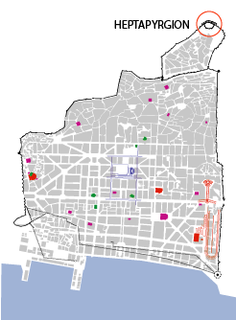 W
WThe Castle of Chios is a medieval citadel in Chios town on the Greek island of Chios.
 W
WThe Castle of Mytilene, also Fortress of Mytilene, is located in Mytilene on the Greek island of Lesbos, North Aegean. It is maintained in good condition and is one of the largest castles in the Mediterranean covering an area of 60 acres. The first castle on the site may have been erected during the time of Justinian I. The 6th-century castle may have been built on top of an already existent fortress. In the late Middle ages, the castle was the residence of Francesco I Gattilusio and his successors, especially the tower known today as the Queen's Tower. There is also strong evidence that the original acropolis on the site may have included a sanctuary to Demeter, Kore and Cybele.
 W
WThe Didymoteicho Fortress or Castle, is an ancient and medieval hilltop citadel complex in the town of Didymoteicho, Eastern Macedonia and Thrace, Greece. It has been an important landmark since ancient times due to the strong fortification surrounding it. The castle is accompanied by several myths, one of the most famous is that of the Forty Arches, and is where Charles XII, King of Sweden, is said to have been imprisoned by the Turks.
 W
WThe Heptapyrgion, modern Eptapyrgio, also popularly known by its Ottoman Turkish name Yedi Kule, is a Byzantine and Ottoman-era fortress situated on the north-eastern corner of the Acropolis of Thessaloniki in Greece. Despite its name, which in both languages means "Fortress of Seven Towers", it features ten, and was probably named after the Yedikule Fortress in Constantinople. It served as the major redoubt of the city's acropolis, as well as the seat of its garrison commander in Ottoman times, until the late 19th century. It was then converted to a prison, which remained open until 1989. References to the infamous Yedi Kule prison abound in the Greek rebetika songs. Restoration and archaeological work began in the 1970s and continues to this day.
 W
WThe Hexamilion wall was a defensive wall constructed across the Isthmus of Corinth, guarding the only land route onto the Peloponnese peninsula from mainland Greece.
 W
WRiniasa Castle, originally known as Thomokastron, is a medieval Byzantine fortress on the coast of Epirus, close to the modern village of Riza near Preveza. The castle is today in a ruinous condition.
 W
WRogoi is a Byzantine castle in Nea Kerasounta near Preveza, in western Greece. It is located on the site of the ancient city of Bouchetion (Βουχέτιον), which was abandoned in the late 1st century BC. Re-occupied in the 9th century, it became a bishopric and was refortified, playing an important role in the region's history in the 14th and early 15th centuries. It was abandoned again after the Ottoman conquest in 1449.
 W
WSkiathos Castle or simply Kastro is a medieval fortified site on the northern tip of the island of Skiathos in Greece, which was the main settlement of the island from the mid-14th century to 1829. It is now abandoned and a protected site.
 W
WThe Walls of Thessaloniki are the city walls surrounding the city of Thessaloniki during the Middle Ages and until the late 19th century, when large parts of the walls, including the entire seaward section, were demolished as part of the Ottoman authorities' restructuring of Thessaloniki's urban fabric. The city was fortified from its establishment in the late 4th century BC, but the present walls date from the early Byzantine period, ca. 390, and incorporate parts of an earlier, late 3rd-century wall. The walls consist of the typical late Roman mixed construction of ashlar masonry alternating with bands of brick. The northern part of the walls adjoins the acropolis of the city, which formed a separate fortified enceinte, and within it lies another citadel, the Heptapyrgion, popularly known by the Ottoman translation of the name, Yedi Kule.